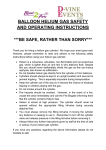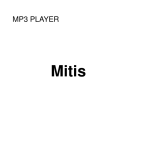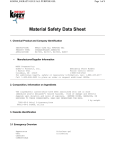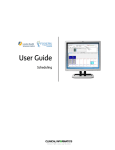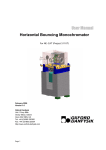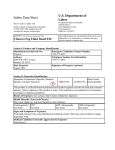Download Refillable High Flow Bottle with High Flow Valve - MIL-SIM
Transcript
SECTION 1: PRODUCT AND COMPANY IDENTIFICATION PRODUCT NAME: Refillable Bottles with High Flow Valves PRODUCT USE: This device is used with various types of non-pyrotechnic explosion simulators. The rapid release of gas from a device is used to generate audio and visual effects. This product can be filled with liquid CO2, vapor CO2, vapour N2, or compressed air. WHMIS CLASSIFCATION: A MANUFACTURER: MIL-SIM-FX International Inc. ADDRESS: 102 Spruce St. Unit A/B, Tillsonburg Ontario N4G 5V3 EMERGENCY PHONE: 1(519) 688-0287 ext 43 SECTION 2: INFORMATION ON INGREDIENTS Each device is composed of a stainless steel cylindrical body and a brass valve. It is designed to be filled with liquid CO2, vapor CO2, vapour N2 or compressed air. SECTION 3: HAZARDS IDENTIFICATION EMERGENCY OVERVIEW: The main health hazards are associated with the rapid release of compressed gas from the device. Note that this device is equipped with a safety release valve to prevent the cylindrical body from rupturing. Unintentional rapid release of compressed gas may occur when: - the device is subject to temperatures in excess of 50° C; - the device’s structural integrity degrades as a result of repeated use; - the device’s structural integrity degrades as a result of exposure to corrosive substances. Note: the device is most susceptible to the unintentional rapid release of gas when it is filled with liquid CO2 and exposed to temperatures above 50° C. ACUTE HEALTH HAZARDS: - Unintentional rapid release of compressed gas may result in the product acting as a projectile. Wear eye protection when using this device; - Inhalation of high qualities of CO2 or N2 can lead to asphyxia. Do not release CO2 or N2 in confined spaces; and - Rapid release of liquid CO2 results in a sudden temperature decrease, which can damage exposed skin. Wear gloves when handling the device. SECTION 4: FIRST AID MEASURES FIRST AID TREATMENT FOR PHYSICAL TRAUMA: seek appropriate medical attention. FIRST AID TREATMENT FOR INHALATION OF CO2 OR N2: immediately remove victim to uncontaminated area. If not breathing, begin artificial respiration. If breathing is difficult, oxygen may be administered by trained personnel only. Obtain medical attention. FIRST AID TREATMENT FOR SKIN EXPOSURE TO LIQUID CO2: immerse the damaged area in warm water and seek appropriate medical attention. SECTION 5: FIRE-FIGHTING MEASURES FLAMMABILITY: - Air is a non-flammable gas, but will support the combustion of flammable materials; - CO2 is a non-flammable gas and will retard the combustion of flammable materials; and - N2 is a non-flammable gas and will retard the combustion of flammable materials. UNUSUAL FIRE AND EXPLOSION HAZARDS: Compressed gas may vent via the safety release valve when exposed to the heat of a fire. The rapid release of compressed gas may result in the device becoming a projectile. PAGE 1 OF 3 SECTION 6: ACCIDENTAL RELEASE MEASURES STEPS TO BE TAKEN IF THE DEVICE BEGINS LEAKING: If gases are being expelled through the safety release valve, move away from the device until it stops leaking. If CO2 or N2 is expelled into a confined space, take steps to ventilate the area before re-entering. SECTION 7: HANDLING AND STORAGE HANDLING:. Do not drag, roll, slide or drop the device. Secure the device at all times while in use. If user experiences any difficulty operating cylinder valve, discontinue use and contact supplier. Never insert an object (e.g., wrench, screwdriver, etc.) into valve cap openings; doing so may damage valve, causing a leak to occur. Do not heat cylinders by any means to increase the discharge rate of gas from the device. Never apply flame or localized heat directly to any part of the device. Devices should not be artificially cooled as certain types of steel undergo property changes when cryogenically cooled, thus making the cylinder unstable. – Cannot say this as artificially cooling the device is what we do to fill them. MAINTENANCE PROCEDURES: - A device should be inspected and maintained in accordance with the Supplementary Maintenance Guidelines; and - in the event of a ruptured safety release valve, that safety release valve must be replaced in accordance with the Product User Manual. PRODUCTSTORAGE REQUIREMENTS: - stored upright and firmly secured to prevent falling or being knocked over; - does not contain compressed gas while in storage; - do not allow storage temperature to exceed 50° C; - stored in dry, well-ventilated areas; - protected from salt or other corrosive materials; - storage should be away from heavily traveled areas, walkways, elevators, platform edges or other objects or situations that could damage the device wall. SECTION 8: EXPOSURE CONTROLS/PERSONAL PROTECTION RESPIRATORY PROTECTION: None normally needed. EYE PROTECTION: Safety glasses in accordance with the Product User Manual. SKIN PROTECTION: Safety gloves in accordance with the Product User Manual. EAR PROTECTION: None is required, but ear protection is required when using the non-pyrotechnic device simulators. See the appropriate operational manual. SECTION 9: PHYSICAL AND CHEMICAL PROPERTIES APPEARANCE OF PRODUCT: A stainless steel cylindrical vessel with a brass high flow valve at one end. SECTION 10: STABILITY AND REACTIVITY CHEMICAL STABILITY: Air, CO2, and N2 are stable. SECTION 11: TOXICOLOGICAL INFORMATION TOXICOLOGICAL INFORMATION FOR AIR: poses no toxicological risks. TOXICOLOGICAL INFORMATION FOR CO2: acute exposure can impair repertory function. See the appropriate MSDS document. TOXICOLOGICAL INFORMATION FOR N2: acute exposure can impair repertory function. See the appropriate MSDS document. SECTION 12: ECOLOGICAL INFORMATION N/A SECTION 13: DISPOSAL CONSIDERATIONS DISPOSAL: Units that are no longer fit for use can be disposed of with house hold waste or recycled. Ensure unit is empty before disposing. PAGE 2 OF 3 SECTION 14: TRANSPORT INFORMATION US DOT: Shipping name: air, compressed Hazard class: 2.2 UN number: UN 1002 IATA: Shipping name: air, compressed Hazard class: 2.2 UN number: UN 1002 SECTION 15: REGULATORY INFORMATION WHMIS CLASSIFICATION: A OSHA: N/A SERA: N/A TSCA: N/A SECTION 16: OTHER INFORMATION The intent of this Product Safety Data Sheet is to provide end users of this product with the health and physical hazards associated with this product and with the gases intended for use with this product. All statements, technical data and recommendations are based on readily available texts and data that MIL-SIM-FX International Inc. believes to be reliable and accurate. MIL-SIM-FX International Inc. makes no warranties, guarantees or representations of any kind with respect to this product or this data. It is the responsibility of the user to obtain and use the most recent version of this PSDS. PAGE 3 OF 3



